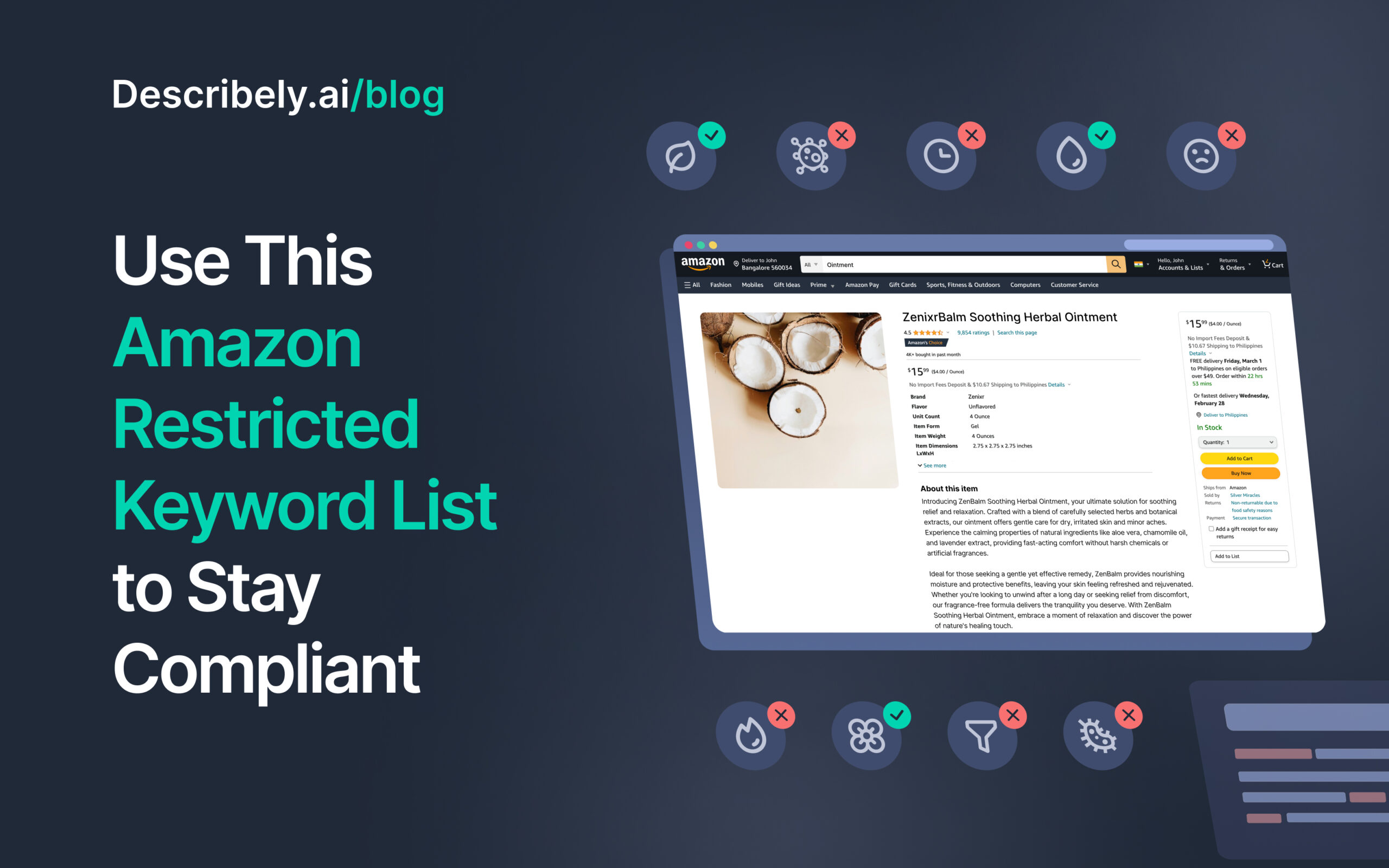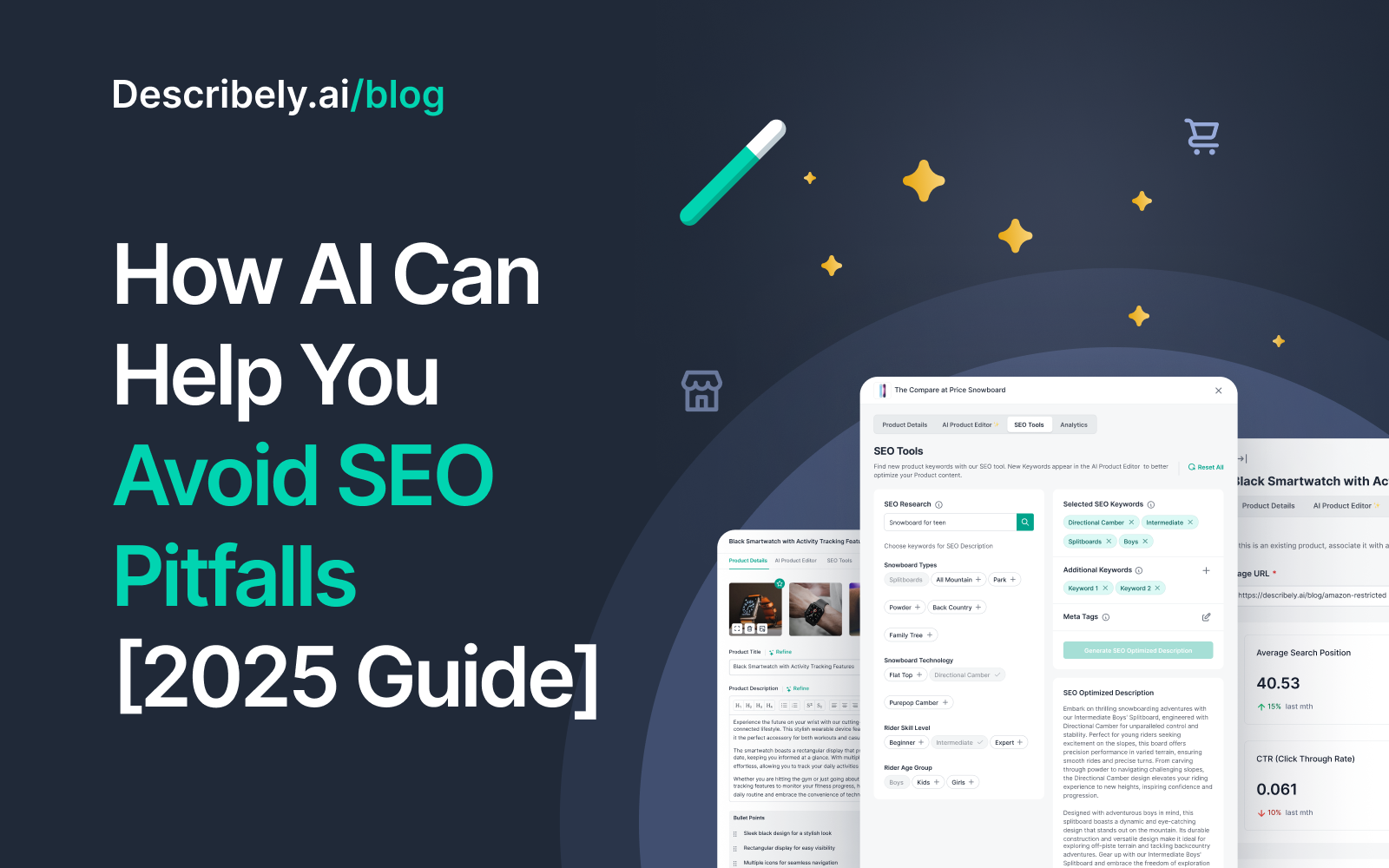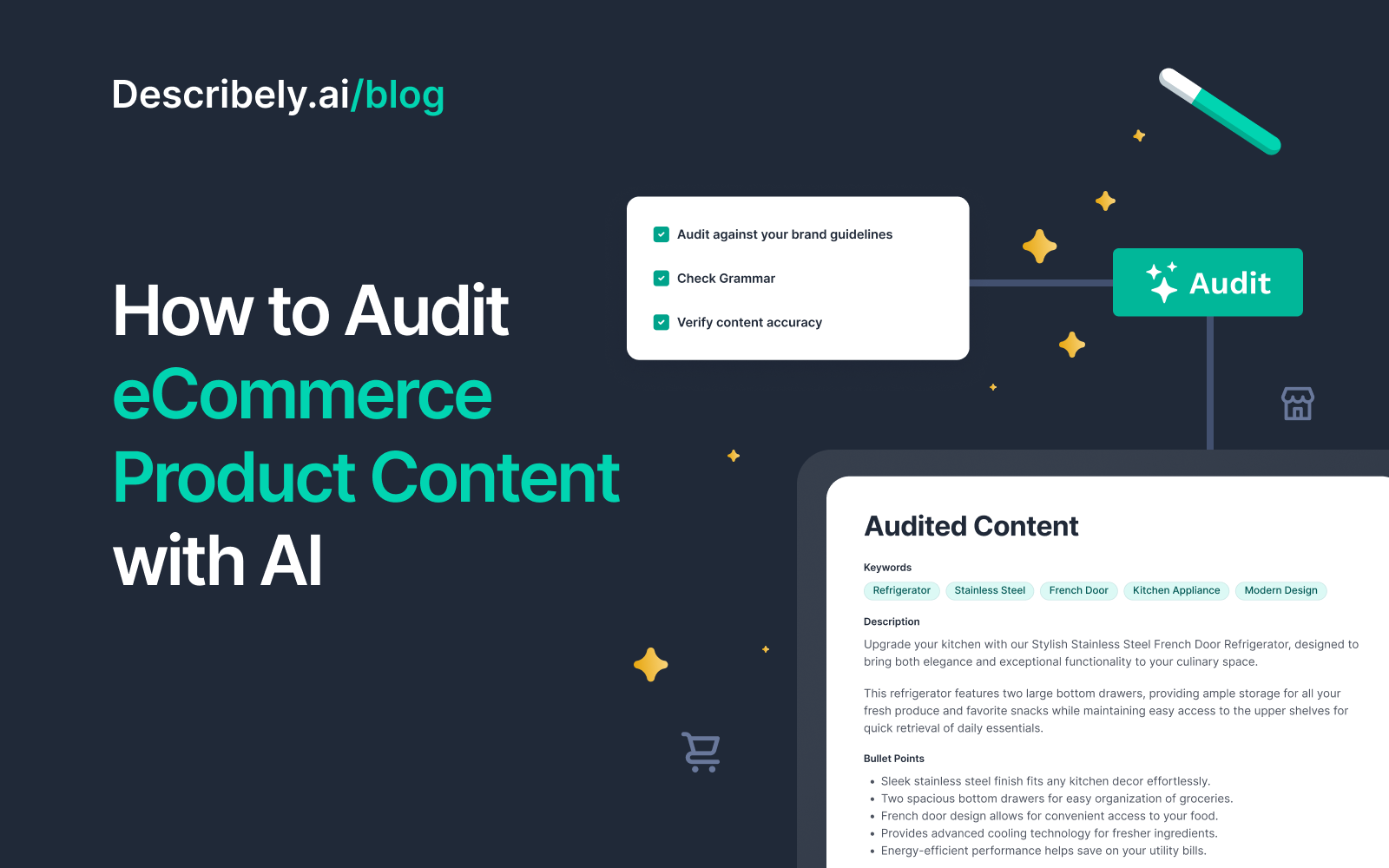
How to Audit eCommerce Product Content with AI
When it comes to your eCommerce store, your product content is the window (aka, the first impression) of your brand. If you’re not careful about the way you refine and audit your content, blunders like the one below are bound to happen.

At Describely, our users told us that they had dire need to leverage AI such that it can review, refine, and audit content in bulk, so you don’t end up making mistakes like these and risking your brand value and image.
This is why we’ve recently launched our content auditing feature (you can learn more about it here).
Having said that, in this piece, we’re taking a deep drive to learn about the importance of product content auditing, what it can do for you, and how to audit product descriptions with the help of AI. (We also have a product description audit checklist in store for you!)
Let’s get right to it!
What is product content auditing?
In a broader sense, eCommerce content audit refers to auditing the entirety of the content on your website, socials, and all the platforms you have a presence on.
So, that includes evaluating things like website speed, SEO optimization, SERP rankings, content accessibility, structure, format, updates/refreshes, etc.
However, when we strictly speak of product content auditing, the following things come into consideration:
- Checking product claims in the descriptions to see if they’re accurate or not.
- Analyzing grammatical mistakes and misspellings in the content.
- Auditing if the content matches the brand’s guidelines and campaign requirements (e.g., product catalogs have to be renewed for popular holiday campaigns like Christmas and New Years).
With Describely’s new product description audit feature, you can put our AI to work and ask it to oversee the above use cases (more importantly, it can save you time by doing it in bulk, too).
Why should you audit your eCommerce product content?
Auditing product content is an industry best-practice for the following reasons:
- It helps you avoid harmful or misleading claims (have you heard about the time where Cadbury got served by the government and ruined its brand reputation because it was advertising misleading claims?)
- It allows you to retain customer trust and build a sustained brand reputation.
- You end up saving time by allowing AI to fact-check, edit, and review the contents your team or contractors produce (i.e. if you only have to accept/reject a shortlisted version of claims vs. rewrite something from scratch, which option would you choose?)
- Over a period of time, you drastically reduce the number of errors in your product copy (i.e., even small typos can be avoided) and you create a systemized process to adhere to your brand guidelines every time.
How to audit your product content using AI?
In the section below, we’re going to be focused on how to do content auditing on your product pages using AI.
1. Using AI to polish up your product copy
If your content is written by a human, there’s a possibility that there might be some grammatical errors in your copy—either through misspellings, excessive use of passive voice, using the wrong phrases, etc.
So, before you put your editors to work to polish up your product copy, let AI have a run at it first so it can remove the surface-level mistakes for you and allow your editors to work on things like structure, format, and effectiveness of your message.
In Describely, you can undertake this task by going to your product catalog, selecting the products you wish to audit, and then clicking on “Audit.”
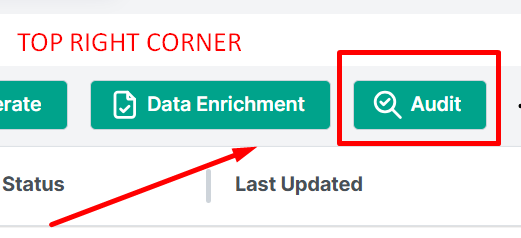
Once you do that, a window will open where, out of the listed options, you’ll need to select “Check for misspellings and grammatical errors in the content.”
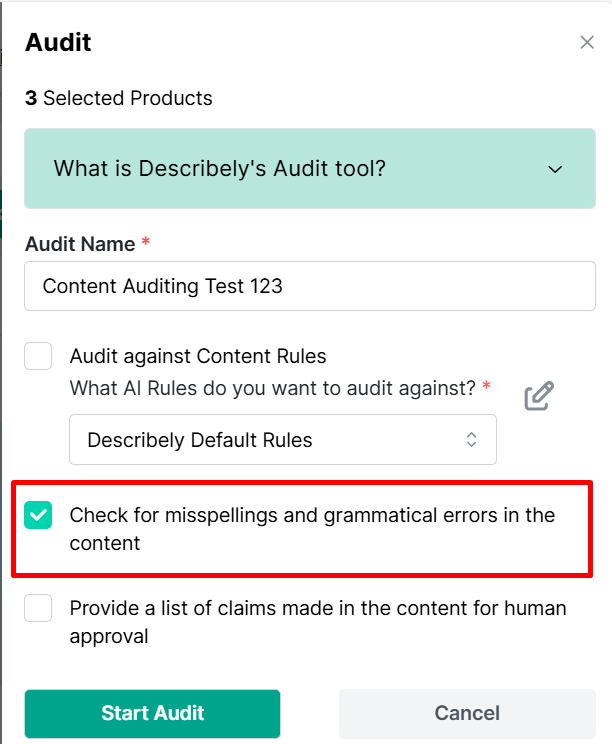
From hereon, Describely will come back with grammatical errors and suggestions for improvements in your copy. All you’ll need to do is accept or ignore the suggestion—and approve the revised version for the final copy.
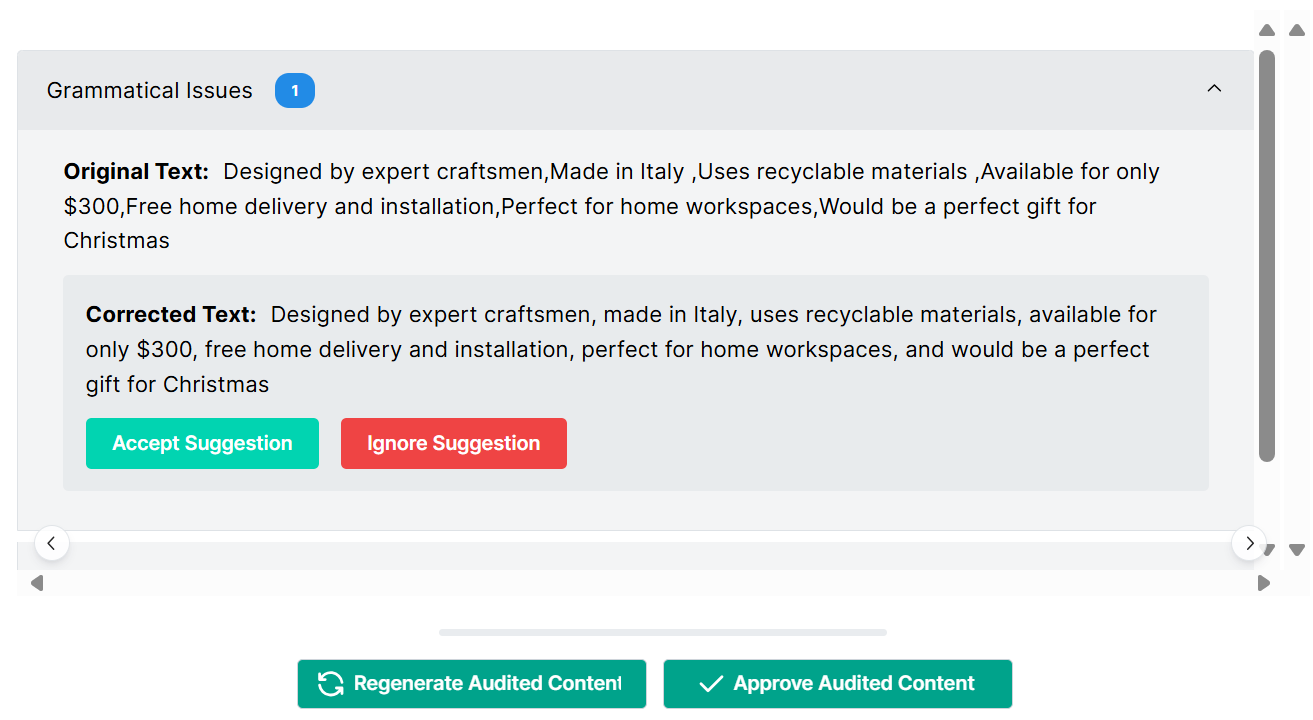
If you’re dealing with an extensive library of products, you can even look up products using keywords or filter the list based on the status of your approval as well as if (according to the AI) the copy requires any updates/changes.
2. Using AI to adhere to content rules
Almost every eCommerce company has a style guide which dictates how every piece of content (written or otherwise) should be produced. In Describely, you get the option of customizing your style guide with the help of “Content Rules.”
With this option, you can set instructions on how you’d like our AI to write and edit your content, tell us about your brand tone, and even add a list of restricted keywords you’d like to avoid (this becomes really helpful in the case when you’re advertising your products on platforms like Amazon which have a restricted keyword list).
For reference, here’s what the feature looks like in action:
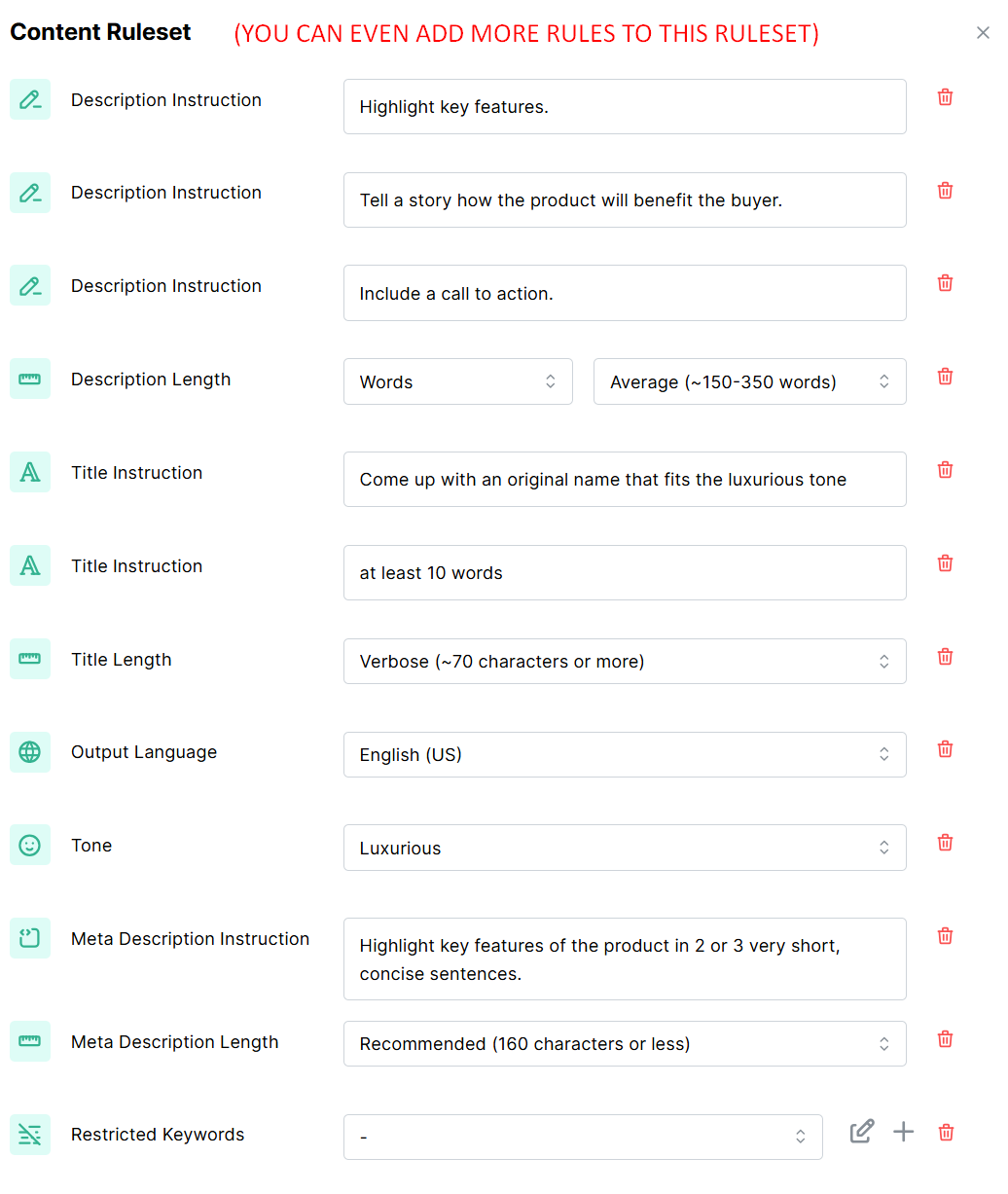
We’d imagine once you’ve gone through the tedious task of creating/updating product descriptions for a campaign, you’d obviously like your descriptions to match the instructions in your style guide, and this is another use case where you can use AI.
AI can recheck if all the instructions in your style guide (i.e., content ruleset) have been met. To do this in Describely, you’ll need to follow the same process as before (aka, going to your product catalog, selecting the products you wish to audit, and clicking on the “Audit” option).
Again, a window will pop up where you’ll need to select the option of “Audit Against Content Rules” and select which ruleset you’d like it to use for reference.
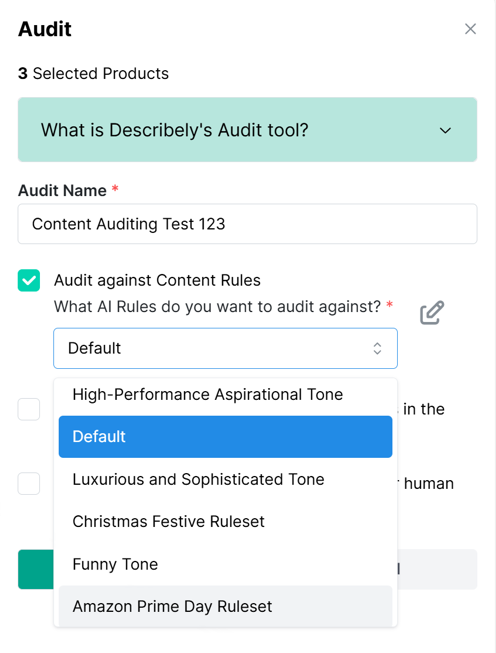
Once that’s done, our AI will come back with a list of failed content validation—aka, areas where your content rules weren’t followed. (It can look something like the image below.)
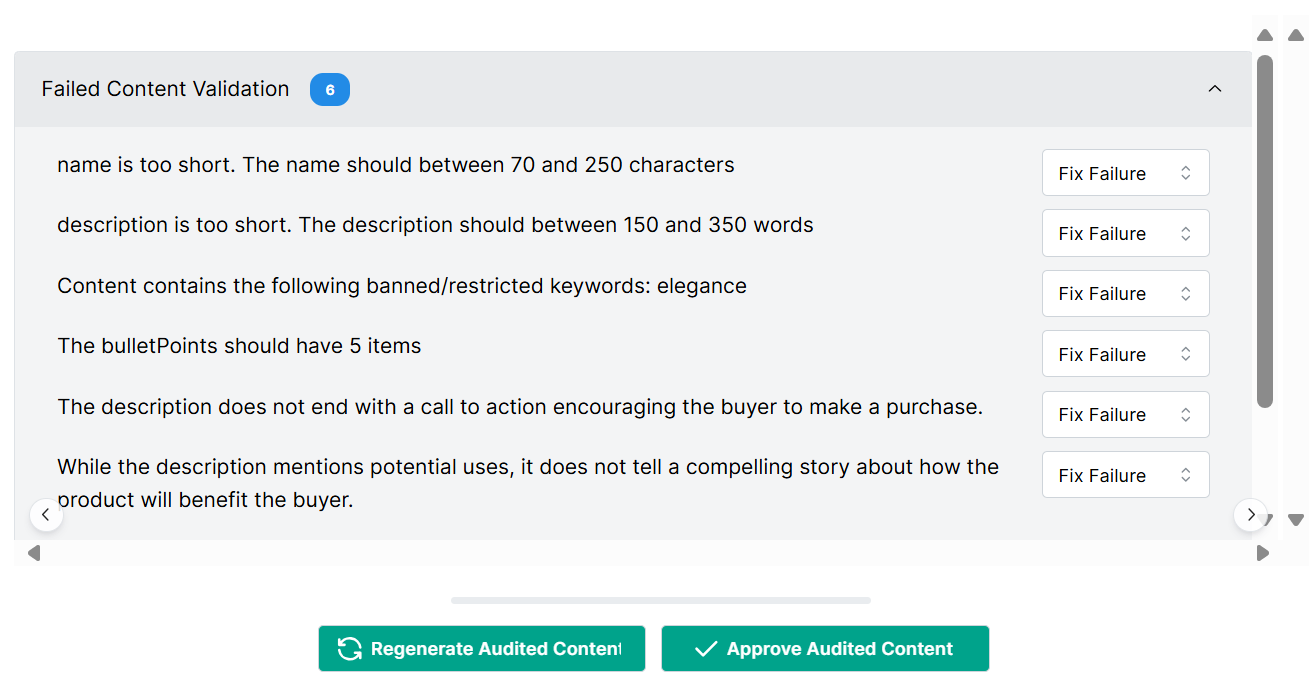
You can either click on the option of “Fix Failure” or “Ignore.” Following this, you can even ask Describely to edit the places to match the requirements in your content rules by clicking on “Regenerate Audited Content.”
Once you’ve regenerated your content and are satisfied with it, click on “Approve Audited Content,” and Describely will automatically add this new copy to your catalog.
3. Using AI to confirm the claims you’re making
Using AI to confirm the validity of your claims is perhaps one of the most important use cases of AI, and we say this not only because it will allow you to avoid a myriad of legal troubles, but also because the right claims in your product copy will set the right impression with your customers.
For example, check out this post on social media regarding Laiki Black Rice Crackers and the impression it set on the customer’s mind.
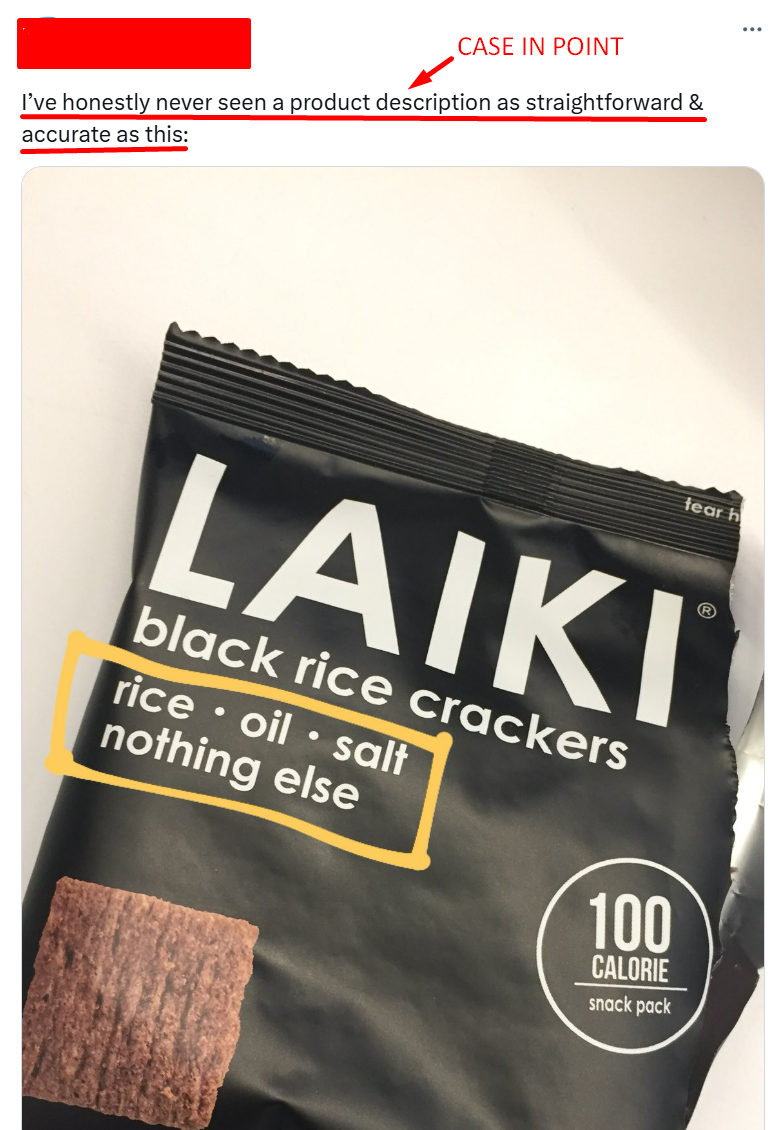
In fact, Laiki’s not only famous for the right information on its product packaging, but the descriptions on its website product pages get full marks, too. For reference, here’s what its description (for the same rice cracker) looks like on the PDP:
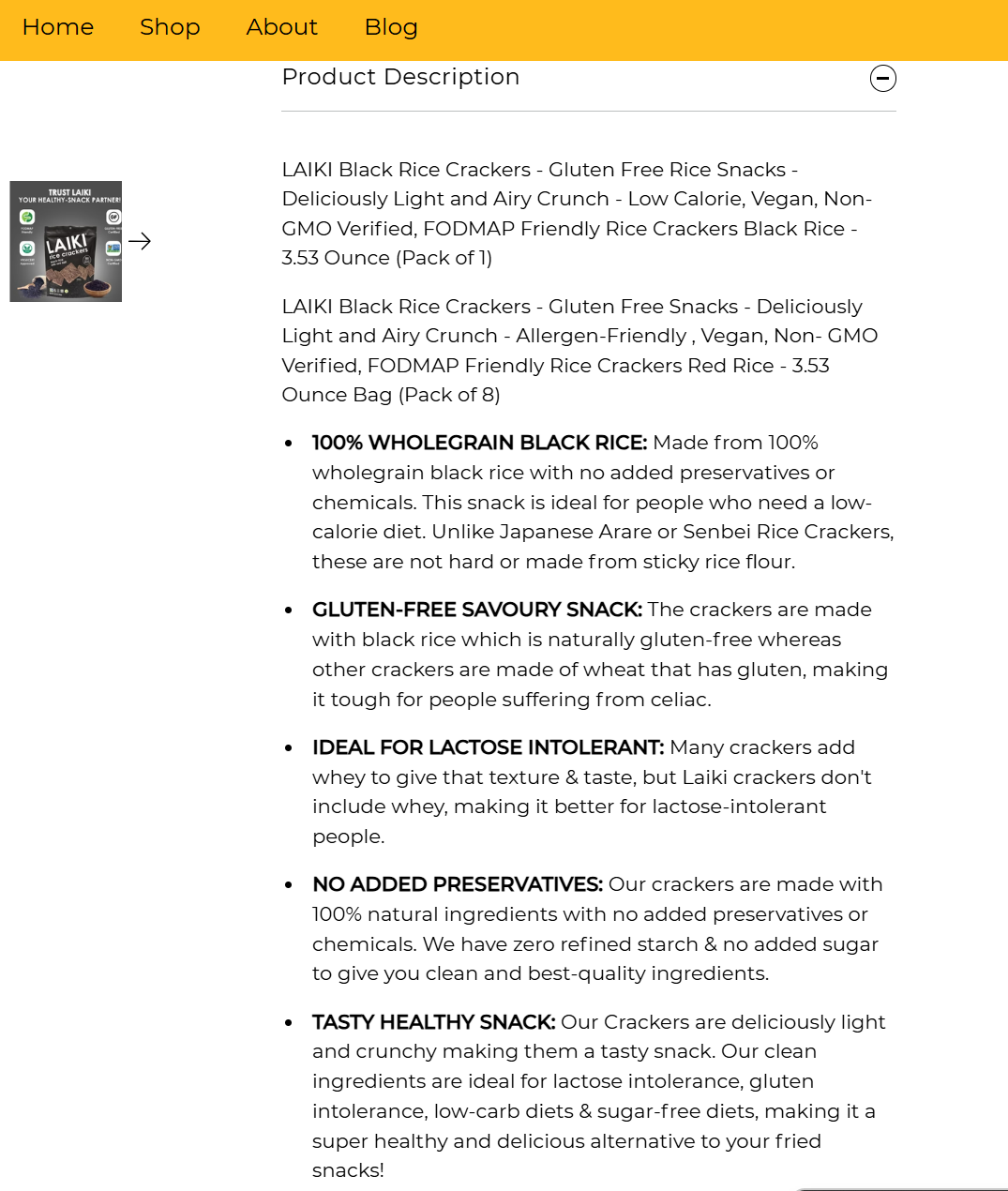
Now, imagine if just one thing in this product description was wrong?
For example, if the writer were to forget which diet types the snack is suitable for (i.e., lactose-free, sugar-free, gluten-free, and low-carb diets) or the way the rice cracker feels (i.e., not hard or made from sticky rice flour), it could have completely changed the impact and effect of the description, which could negatively impact sales.
Besides, inaccurate product claims may be a common mistake to make these days because eCommerce content teams are always under tight deadlines; some are completely using AI to extract product information from images, or using freelancers with little product knowledge to write the content, or have ties with manufacturers/suppliers who make misleading claims.
Anywho, back to the point: You can now rely on AI to fact-check your claims. How to do this, you ask? Well, in Describely, you’ll need to click on all the products you’d like to fact-check, click on “Audit,” and select the “Provide a list of claims made in the content for human approval” option.
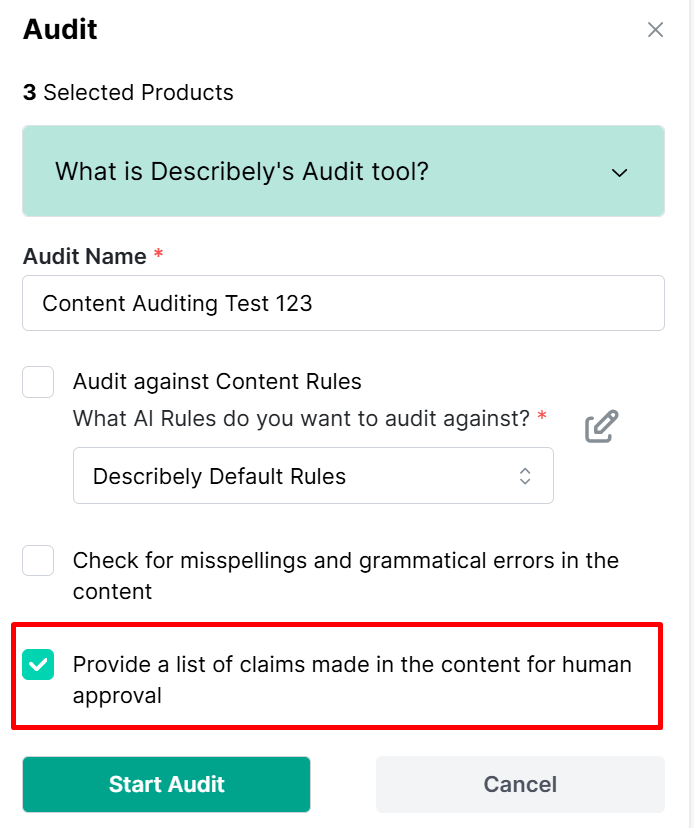
Once Describely’s done auditing your content, it’ll come back with a list of claims made in the product copy that you get to accept or reject. (You’ll also get the option to “Accept All” or “Reject All”.)
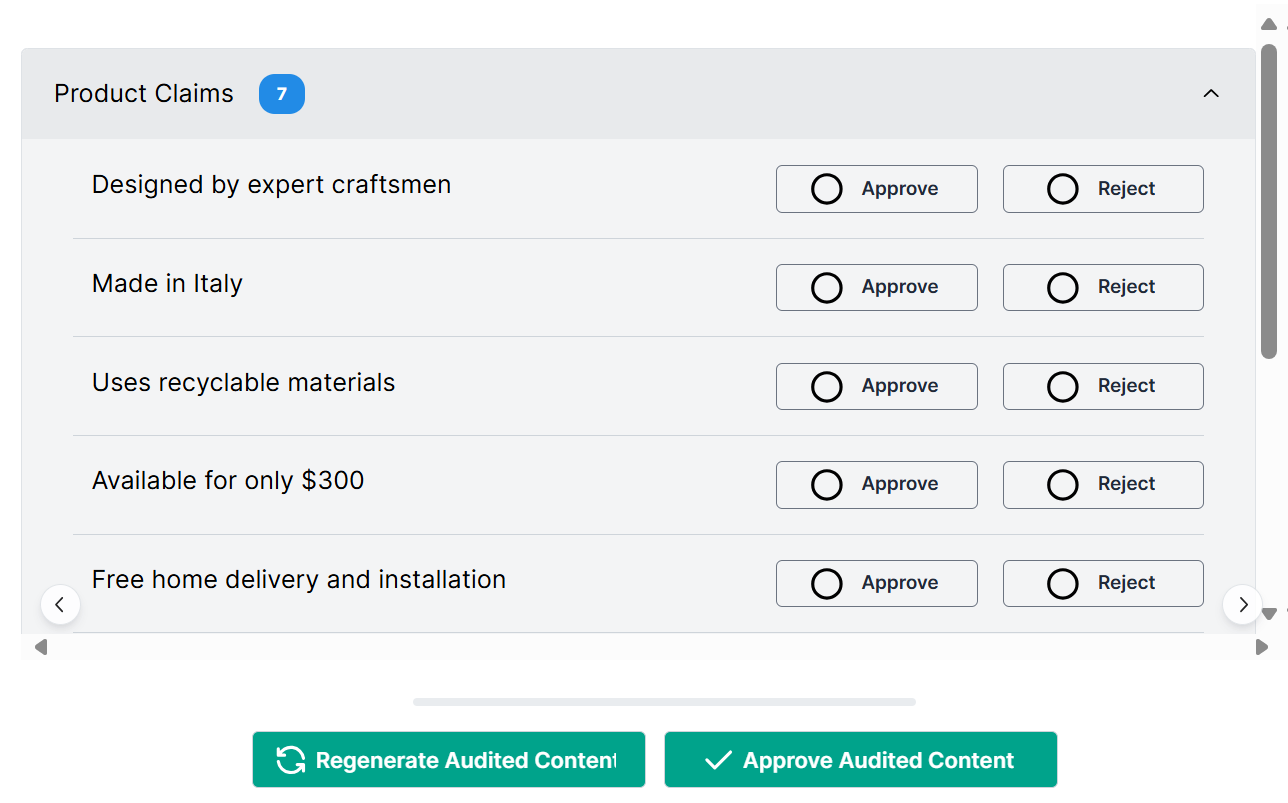
If you reject any claims, you can also ask Describely to rewrite your content (with only factual information) by clicking on the “Regenerate Audited Content” option.
4. Using AI to update and refresh your descriptions
If you’re gearing up to refresh your product descriptions as part of your eCommerce content audit goals—either because they’ve been sitting on the shelf non-updated for way too long or because you want to revamp them with a new campaign in mind—that’s another area where AI can help you out.
In Describely, there are two ways you can do this:
Option A: Creating a new content ruleset to update your copy
You can create campaign-specific content rulesets on Describely and ask its editor to create descriptions based on the ruleset. For example, here’s what a Christmas ruleset could look like:
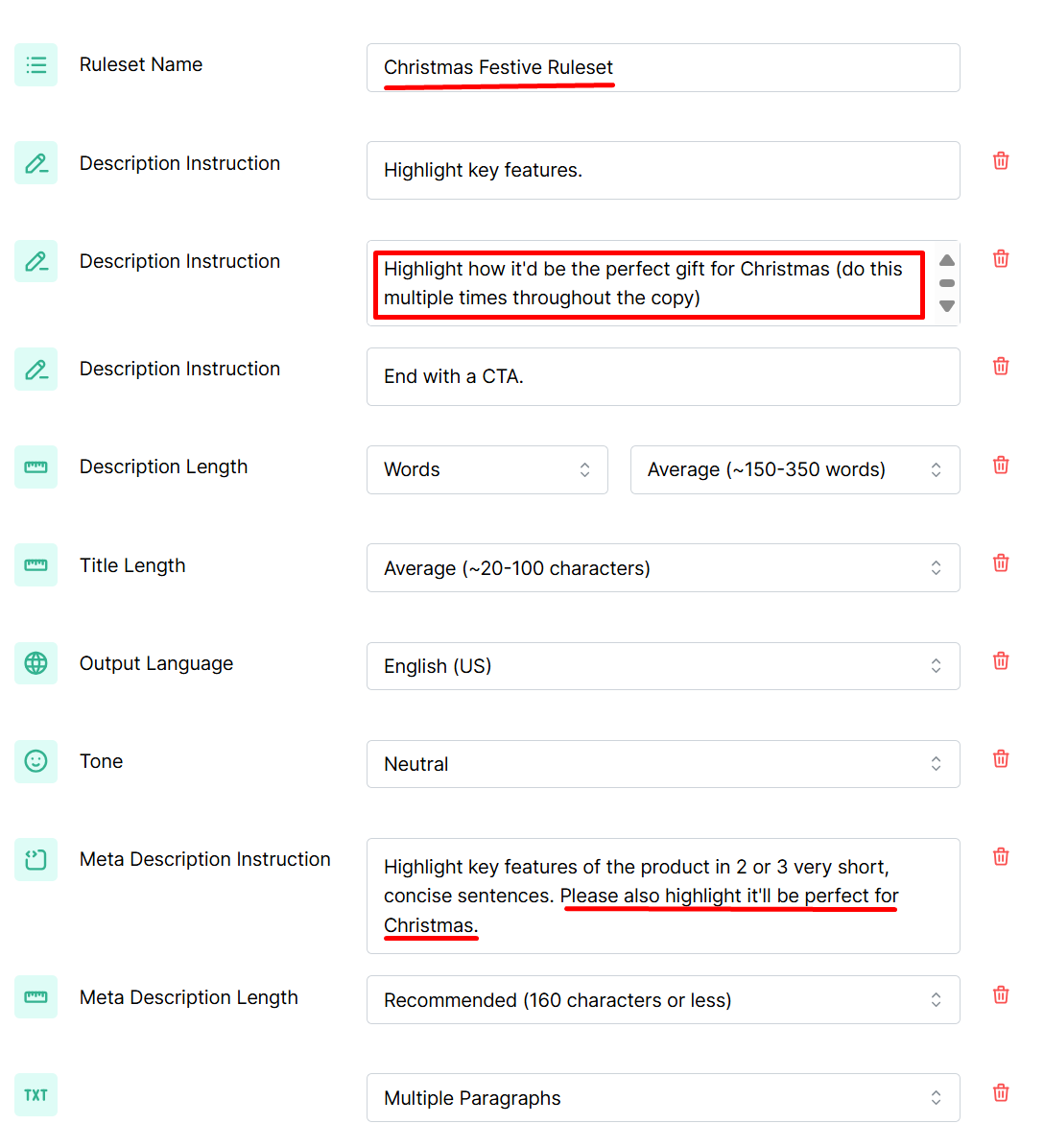
You can then ask Describely’s editor to create/update descriptions—by clicking on “Refine”—-based on the instructions set in the particular ruleset.

Option B: Feeding new information to the product editor
Alternatively, if the above option is not working well for you, you can feed new information to Describely’s Editor with the help of product bullet points (you’ll find this option in the “Product Details” section) or by feeding custom instructions/product details in the box.
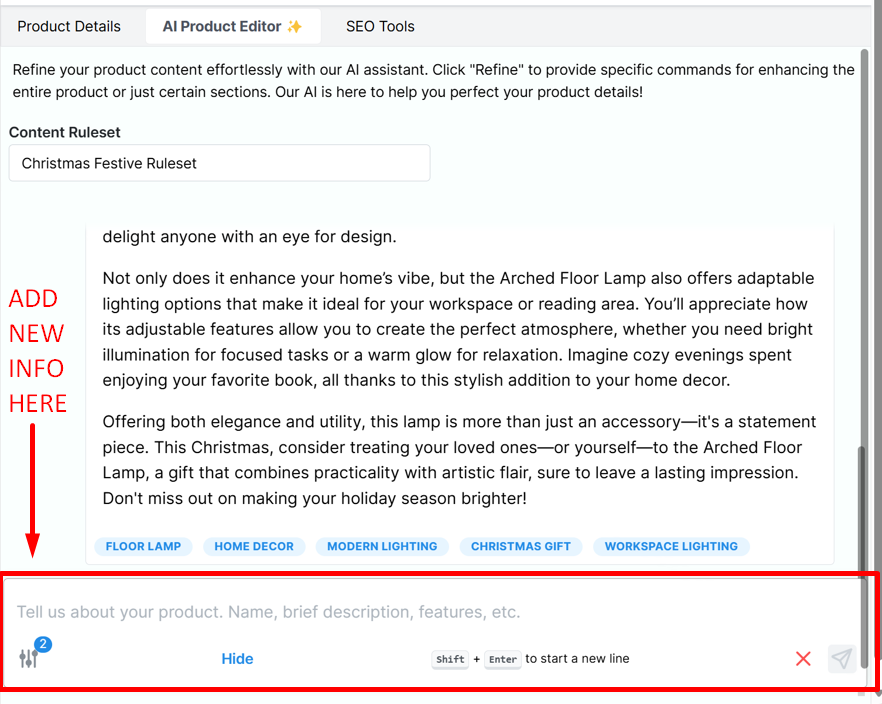
5. Using AI to optimize your copy for organic search results and SEO rankings
Last but not least, if your content auditing goal is to optimize your product copy for SERPs, you’ll be happy to know that you can rely on AI like Describely to:
- Do SEO research (i.e., it’ll come back with a list of keywords based on the phrase or title you give it).
- Add additional keywords to your copy (e.g., if you use a complementary tool like Ahrefs or SEMRush to do keyword research, you can provide the list of keywords to Describely and ask it to integrate those in the product copy).
- Create meta tags (aka, you can create meta titles and descriptions based on the instructions you feed it).
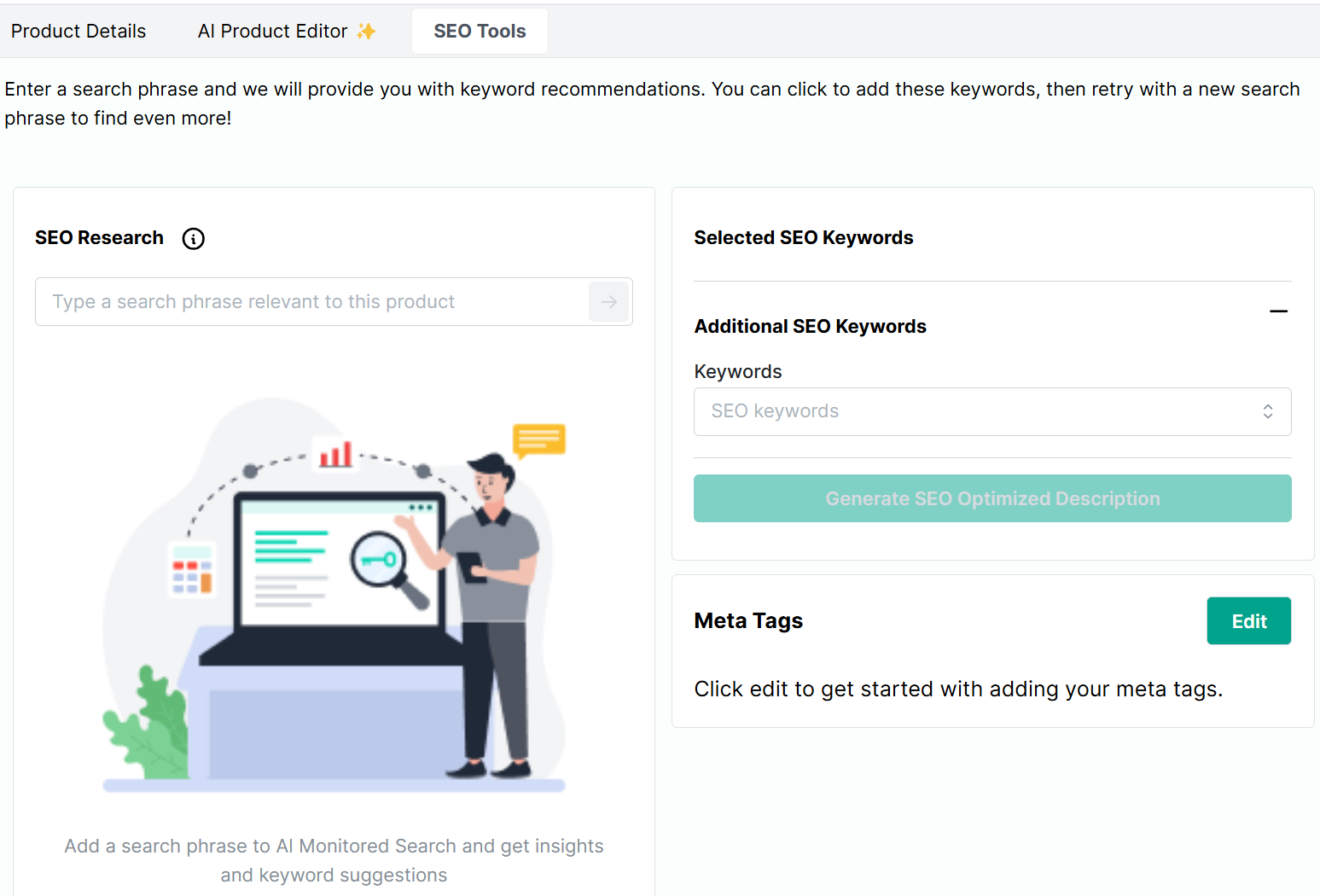
On that note, you can make your content auditing process more refined by again relying on complementary SEO tools like Ahrefs or SEMRush to do site-wide auditing and finding more insights into things like ranking, product page performance, content accessibility, etc.
Scenarios where product content auditing are important
In case you use the help of freelancers to generate product descriptions, having an AI tool to fact-check the claims mentioned in their copy, correct their misspellings and grammatical errors, and verify if the content sent by them is agreeable to your style-guide or not, can be extraordinarily helpful, especially if you have thousands of products to review.
In other instances, Describely’s product description audit feature can be useful to improve user experience or to protect your brand from legal troubles. For example, you can use this feature to refine your product copy based on audience preferences (e.g., even English speaking audiences might have different requirements for British English vs. American English).
As for legal troubles, imagine you’re selling school backpacks and you market them as “waterproof” in your copy when in reality they are not. In such situations, the customer can take to social media to ruin your brand reputation or even take you to court to sue you based on wrongful claims, and you’d have no other option but to take the consequences.
On that note, considering just how important product claims can be in your descriptions, here’s a product description audit checklist which will help you remember the important things to review before publishing your descriptions:
Product Description Audit Checklist
- Product size and dimensions
- Delivery information
- Product availability
- Material information
- Allergen information
- Product certifications
- Return policy
- Call to action(s)
- Legal compliance
- Negative/positive keywords
- Warranty information
- Product usage instructions
Next checklist item: Start auditing your product content!
AI can be a really helpful tool to streamline the process of content creation, editing, and refinement. And there’s perhaps no one better than us to understand its importance, mainly because Describely specializes in leveraging AI for these exact use cases.
With Describely, you can not only create content based on your custom requirements and style guide instructions, but you can also ask our AI to audit and refine your descriptions, fact-check your claims, do SEO research, scour the internet to enrich your content, extract data from images, refresh copies based on campaigns/seasons, etc.
Learn how Describely can help you create content that sells more and ranks higher. Get started now!


